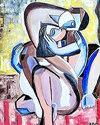“To Enter the Core of Death”
IF 0.3
4区 社会学
0 HUMANITIES, MULTIDISCIPLINARY
ANGELAKI-JOURNAL OF THE THEORETICAL HUMANITIES
Pub Date : 2023-03-04
DOI:10.1080/0969725X.2023.2192068
引用次数: 0
Abstract
Abstract This essay explores figurations of death in Lispector’s The Passion According to G.H. and Água Viva. As the other side of life, death in these novels is tied to the work of the unconscious desire that introduces generative rupture to the narrators’ experience of being, thinking, and writing. In making one wander at the limits of thought, language, and being, death also signals the encounter with femininity which leads to the disintegration of the human montage. While in Água Viva the encounter with death unfolds through the instant – as the fleeting yet irreducible nowness – in The Passion it manifests through a gustatory and aural encounter with the mute cockroach and the absent maid’s mural. Along the way, the essay explores the specific savoir coming from death in Lispector’s novels alongside the clinic of psychoanalysis, primarily the recent work of the Freudian School of Quebec that has placed special focus on the links between the death drive and the aesthetic experience. I bring Lispector’s novels into conversation with psychoanalysis to propose that Clarice’s writing – just like the psychoanalytic clinic – fundamentally arises from the desire to uphold the unsayable dimension of death whose creative unfolding enables new modes of being, hearing, and thinking in – and with – the world. Indeed, in Clarice’s novels, to be on the side of writing is to be on the side of death that is both the herald of writing and the ravaging reverberation of the force of writing itself.“进入死亡的核心”
摘要本文探讨了利斯佩克特的《根据G.H.和Água Viva的激情》中的死亡形象。作为生命的另一面,这些小说中的死亡与无意识欲望的作品联系在一起,无意识欲望给叙述者的存在、思考和写作体验带来了生成性断裂。在思想、语言和存在的极限上徘徊时,死亡也标志着与女性气质的相遇,这导致了人类蒙太奇的解体。而在《Água Viva》中,与死亡的相遇通过瞬间展开——作为短暂但不可还原的已知——在《激情》中,它通过与沉默的蟑螂和缺席的女仆壁画的味觉和听觉相遇来表现。在这一过程中,本文探讨了利斯佩克特小说中来自死亡的具体智慧,以及精神分析诊所,主要是魁北克弗洛伊德学派最近的作品,该作品特别关注死亡驱动力和审美体验之间的联系。我将利斯佩克特的小说与精神分析进行了对话,提出克拉丽斯的写作——就像精神分析诊所一样——从根本上源于维护死亡这一无法言说的维度的愿望,这种维度的创造性展开使人们能够在世界中以及与世界相处时获得新的存在、听觉和思维模式。事实上,在克拉丽斯的小说中,站在写作一边就是站在死亡一边,死亡既是写作的先驱,也是写作力量本身的毁灭性回响。
本文章由计算机程序翻译,如有差异,请以英文原文为准。
求助全文
约1分钟内获得全文
求助全文
来源期刊

ANGELAKI-JOURNAL OF THE THEORETICAL HUMANITIES
HUMANITIES, MULTIDISCIPLINARY-
CiteScore
0.60
自引率
33.30%
发文量
57
期刊介绍:
Angelaki: journal of the theoretical humanities was established in September 1993 to provide an international forum for vanguard work in the theoretical humanities. In itself a contentious category, "theoretical humanities" represents the productive nexus of work in the disciplinary fields of literary criticism and theory, philosophy, and cultural studies. The journal is dedicated to the refreshing of intellectual coordinates, and to the challenging and vivifying process of re-thinking. Angelaki: journal of the theoretical humanities encourages a critical engagement with theory in terms of disciplinary development and intellectual and political usefulness, the inquiry into and articulation of culture.
 求助内容:
求助内容: 应助结果提醒方式:
应助结果提醒方式:


